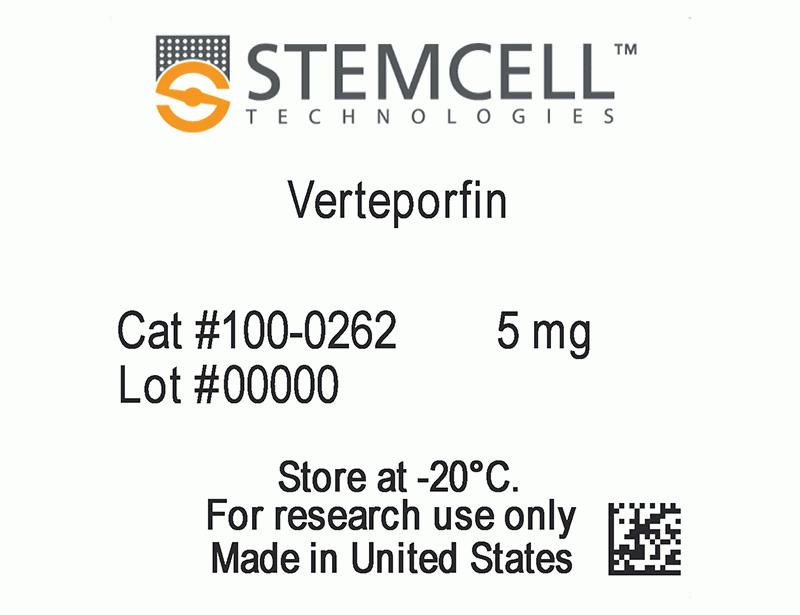Verteporfin
YAP1 inhibitor
概要
Verteporfin is a benzoporphyrin derivative that inhibits autophagosome formation by directly targeting and modifying p62, a scaffold protein that targets polyubiquitinated proteins for degradation (Donohue et al.). Verteporfin also disrupts YAP-TEAD interactions by enhancing trypsin cleavage of YAP (EC₅₀ = 100 nM; Brodowska et al.; Liu-Chittenden et al.).
CANCER RESEARCH
· Inhibits the growth, proliferation, and viability of human retinoblastoma cells (Brodowska et al.).
· Inhibits self-renewal in cancer stem cells with high YAP1 and ALDH1 levels (Song et al.).
CANCER RESEARCH
· Inhibits the growth, proliferation, and viability of human retinoblastoma cells (Brodowska et al.).
· Inhibits self-renewal in cancer stem cells with high YAP1 and ALDH1 levels (Song et al.).
Alternative Names
BPD-MA; CL 318,952
Area of Interest
Autophagy, Cancer Research
CAS Number
129497-78-5
Chemical Formula
C₄₁H₄₂N₄O₈
Molecular Weight
718.8 g/mol
Purity
≥ 95%
Target
p62, YAP1
技术资料
| Document Type | 产品名称 | Catalog # | Lot # | 语言 |
|---|---|---|---|---|
| Product Information Sheet | Verteporfin | 100-0261, 100-0262 | All | English |
| Safety Data Sheet | Verteporfin | 100-0261, 100-0262 | All | English |
数据及文献
Publications (4)
Experimental eye research 2014 jul
The clinically used photosensitizer Verteporfin (VP) inhibits YAP-TEAD and human retinoblastoma cell growth in vitro without light activation.
Abstract
Abstract
Verteporfin (VP), a benzoporphyrin derivative, is clinically used in photodynamic therapy for neovascular macular degeneration. Recent studies indicate that VP may inhibit growth of hepatoma cells without photoactivation through inhibition of YAP-TEAD complex. In this study, we examined the effects of VP without light activation on human retinoblastoma cell lines. Verteporfin but not vehicle control inhibited the growth, proliferation and viability of human retinoblastoma cell lines (Y79 and WERI) in a dose-dependent manner and was associated with downregulation of YAP-TEAD associated downstream proto-oncogenes such as c-myc, Axl, and surviving. In addition VP affected signals involved in cell migration and angiogenesis such as CTGF, cyr61, and VEGF-A but was not associated with significant effect on the mTOR/autophagy pathway. Of interest the pluripotency marker Oct4 were downregulated by Verteporfin treatment. Our results indicate that the clinically used photosensitizer VP is a potent inhibitor of cell growth in retinoblastoma cells, disrupting YAP-TEAD signaling and pluripotential marker OCT4. This study highlights for the first time the role of the YAP-TEAD pathway in Retinoblastoma and suggests that VP may be a useful adjuvant therapeutic tool in treating Rb patients.
Cancer research 2014 aug
Hippo coactivator YAP1 upregulates SOX9 and endows esophageal cancer cells with stem-like properties.
Abstract
Abstract
Cancer stem cells (CSC) are purported to initiate and maintain tumor growth. Deregulation of normal stem cell signaling may lead to the generation of CSCs; however, the molecular determinants of this process remain poorly understood. Here we show that the transcriptional coactivator YAP1 is a major determinant of CSC properties in nontransformed cells and in esophageal cancer cells by direct upregulation of SOX9. YAP1 regulates the transcription of SOX9 through a conserved TEAD binding site in the SOX9 promoter. Expression of exogenous YAP1 in vitro or inhibition of its upstream negative regulators in vivo results in elevated SOX9 expression accompanied by the acquisition of CSC properties. Conversely, shRNA-mediated knockdown of YAP1 or SOX9 in transformed cells attenuates CSC phenotypes in vitro and tumorigenicity in vivo. The small-molecule inhibitor of YAP1, verteporfin, significantly blocks CSC properties in cells with high YAP1 and a high proportion of ALDH1(+). Our findings identify YAP1-driven SOX9 expression as a critical event in the acquisition of CSC properties, suggesting that YAP1 inhibition may offer an effective means of therapeutically targeting the CSC population.
PloS one 2014
Induction of Covalently Crosslinked p62 Oligomers with Reduced Binding to Polyubiquitinated Proteins by the Autophagy Inhibitor Verteporfin.
Abstract
Abstract
Autophagy is a cellular catabolic process responsible for the degradation of cytoplasmic constituents, including organelles and long-lived proteins, that helps maintain cellular homeostasis and protect against various cellular stresses. Verteporfin is a benzoporphyrin derivative used clinically in photodynamic therapy to treat macular degeneration. Verteporfin was recently found to inhibit autophagosome formation by an unknown mechanism that does not require exposure to light. We report that verteporfin directly targets and modifies p62, a scaffold and adaptor protein that binds both polyubiquitinated proteins destined for degradation and LC3 on autophagosomal membranes. Western blotting experiments revealed that exposure of cells or purified p62 to verteporfin causes the formation of covalently crosslinked p62 oligomers by a mechanism involving low-level singlet oxygen production. Rose bengal, a singlet oxygen producer structurally unrelated to verteporfin, also produced crosslinked p62 oligomers and inhibited autophagosome formation. Co-immunoprecipitation experiments demonstrated that crosslinked p62 oligomers retain their ability to bind to LC3 but show defective binding to polyubiquitinated proteins. Mutations in the p62 PB1 domain that abolish self-oligomerization also abolished crosslinked oligomer formation. Interestingly, small amounts of crosslinked p62 oligomers were detected in untreated cells, and other groups noted the accumulation of p62 forms with reduced SDS-PAGE mobility in cellular and animal models of oxidative stress and aging. These data indicate that p62 is particularly susceptible to oxidative crosslinking and lead us to propose a model whereby oxidized crosslinked p62 oligomers generated rapidly by drugs like verteporfin or over time during the aging process interfere with autophagy.
Genes {\&} development 2012 jun
Genetic and pharmacological disruption of the TEAD-YAP complex suppresses the oncogenic activity of YAP.
Abstract
Abstract
The Drosophila TEAD ortholog Scalloped is required for Yki-mediated overgrowth but is largely dispensable for normal tissue growth, suggesting that its mammalian counterpart may be exploited for selective inhibition of oncogenic growth driven by YAP hyperactivation. Here we test this hypothesis genetically and pharmacologically. We show that a dominant-negative TEAD molecule does not perturb normal liver growth but potently suppresses hepatomegaly/tumorigenesis resulting from YAP overexpression or Neurofibromin 2 (NF2)/Merlin inactivation. We further identify verteporfin as a small molecule that inhibits TEAD-YAP association and YAP-induced liver overgrowth. These findings provide proof of principle that inhibiting TEAD-YAP interactions is a pharmacologically viable strategy against the YAP oncoprotein.




